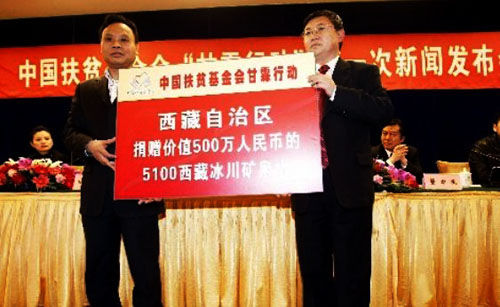Tibet case written in China National Human Development Report 2016
chinagate.cn by Wang Qian, August 24, 2016 Adjust font size:
The United Nations Development Programme (UNDP) launched its 2016 China National Human Development Report in Beijing, on August 22. The report, developed by UNDP China with a team of Chinese and International experts, explores the development challenges of China and recognizes the progress and innovations China has made in reducing poverty.
This report also points out that the poverty in China has been dramatically reduced by the government adopting multiple policy initiatives, which have been implemented according to local context. Most recently, targeted poverty alleviation and industry-led alleviation policies have helped promote inclusive development in poverty stricken areas.
The reason Tibet’s bottled water industry can be written into UNDP’S China National Human Development Report is that it has been adopted to local contexts when boosting industries and alleviating poverty, which is of high reference value for other places of China, or even the rest of the world.
In Tibet, key industries were harnessed to support local development. By promoting opportunities, local companies in the water sector were able to teach new vocational skills to farmers and contribute to local economic growth.
Tibet boasts the best quality of water recourses in the world. The average amount of Tibet’s water resources is about 439 billion cubic metres, representing 16.5% of that of China. In addition, water in Tibet is of high quality and purity, and has been highly recognized all over the world.
Based on Tibet’s geographic characteristics and advantages of having abundant water resources, the bottled water industry, which not only utilizes the rich water resources but does low damage to the environment, has been set as a key industry by the Tibetan government.

Exciting progress has been made in Tibet’s bottled water industry, improving the local economic development and lifting people out of poverty. For example, Xung County, a local county in Tibet, once was a primitive farming and stockbreeding area, located on mountains with an altitude of over 5,100 meters, with an annual average household income of less than 2,000 yuan ($300 U.S dollars) before 2005. However, the Tibet 5100 glacier mineral water company contributes to 80% of the industrial output and billions in annual tax income since its operation. Moreover, 95% of its employees are local Tibetan farmers and all of them receive vocational training. As a result, the people’s livelihood has been drastically improved, with average annual household income reaching 40,000 yuan ($6,000 U.S dollars). At the same time, the company provides more job opportunities by employing the local residents to engage in water transportation, which also increases people’s income.
Notably, the Tibet 5100 glacier mineral water company has done more than boost local industries. It helped build the first village asphalt road and provided basic living electricity to 18 villages, and provided subsidies of nearly 5 million yuan to local farmers to have access to electricity. It has also provided generous support for local education, medical care, and poverty alleviation. For instance, it established a “Tibet 5100 glacier mineral water special education fund”, providing no less than 1 million yuan ($150,000 U.S dollars) to local schools each year.